Abstract
According to many domestic and foreign authors, the current state of the quality of management of organizations does not meet the requirements of the time and needs to find ways to improve it. Usually the concept of «quality» in organizations is associated with the output of products, much less often in the scientific literature is used the term «quality of organization management». In modern management, there is no generally accepted definition of it, and its content is not clearly established, notes Vinokurov V. A. Under the «quality management of the organization» we mean an effective management system, reflected in the growth of economic indicators, in ensuring quality and safety of products and to meet the needs of stakeholders. The article describes the characteristics of the food processing, including the oil and fat industry; key systemic issues that reduce the quality of governance institutions are reviewed; approaches to the quality management of organizations currently existing reviewed; the analysis of the dynamics of the main economic indicators of the organization are reviewed; the main types of losses related to product quality and management quality are identified; measures are proposed to improve the quality of management of the organization; the forecast of economic indicators is given, taking into account the transition to the use of information technologies in the «Purchasing» process..
Keywords: Managementqualityimprovementorganizationeconomic indicatorsinformation technology
Introduction
The food industry of Russia is a combination of more than thirty specialized industries, sub-sectors and individual industries, which consist of diverse organizations of different ownership forms and legal forms. Over the past decade, the food and processing industry has fully completed in the food and processing industry, which has allowed organizations to adapt to the conditions of the market economy (Abakumova & Troshkova, 2019; On approval of the Strategy for improving the quality of food products in the Russian Federation until 2030, 2020).
The fat and oil industry is an important part of the food industry. There are more than 200 oil-producing organizations in the Russian Federation. The main production facilities for oilseed processing are concentrated in the Rostov Region, Krasnodar Territory, Belgorod and Voronezh Regions. The production of products based on vegetable oils is one of the most dynamically developing segments of the oil and fat industry (On approval of the Strategy for improving the quality of food products in the Russian Federation until 2030, 2020).
Problem Statement
The main systemic problems that reduce the quality of management characteristic of all organizations in the fat and oil industry are: lack of agricultural raw materials; moral and physical depreciation of equipment, low level of competitiveness of organizations; undeveloped infrastructure for storage, transportation and logistics of goods distribution; insufficient compliance with environmental requirements (On approval of the Strategy of the food and processing industry of the Russian Federation for the period until, 2020).
The measures taken should be aimed at meeting the needs of the population for high-quality and diverse food products. Thus, we will consider improving the quality of management of the organization of the fat and oil industry as one of the most important ways to improve the competitiveness and economic efficiency of the organization (Abakumova & Levshina, 2017).
Research Questions
Issues in the field of quality management of the organization with by many foreign and domestic researchers have been engaged in: U. E. Deming, J. Juran, K. Ishikawa, T. Conti, F. Crosby, G. Taguchi, A. Feigenbaum, V. Shuhart, E. A. Gorbashko, Yu. P. Adler, O. V. Aristova, V. Ya. Belobragin, B. V. Fighters, G. P. Voronin, V. N. Voitolovsky, V. I. Galeeva, E. B. Gafforova, B. I. Gerasimov, A. V. Glicheva, Evans D., Mikheeva, E. N. and others.
Purpose of the Study
Serenkov (2011) notes, industrial organizations lack an accessible, scientifically based methodology for building and improving the quality of organization management, which would be based on the fundamental principles of classical management, on the one hand, and modern information technologies, on the other. Evans (2015), Mikheeva and Seroshtan (2017) to improve the quality of management of the organization considered a system-integrated approach that allows you to integrate the largest number of factors and technical and economic relationships into the system. Nikolaev (2016) considered in his works models of quality management of the organization.
The approaches to quality management of an organization that have developed at the present time are quite diverse (Table
The purpose of this work is to develop software for automating the «Purchasing» process in order to improve the quality of management of the organization of the fat and oil industry. The object of research is the organization of the fat and oil industry, located in the Krasnoyarsk Territory.
Research Methods
The analysis of the financial condition showed the dynamics of the profit growth and basic economic indicators for the period under review (Table
However, the organization has losses related to product quality and quality management: defects, alterations, returns, production downtime, sales losses (Table
Based on our analysis, we recommend the following measures to improve the quality of management of the organization of the fat and oil industry:
Expansion of distribution outside the Krasnoyarsk Territory.
Develop a bonus program for fulfilling the terms of the agreement.
Automation of the «Purchasing» process through software development.
The stages of the Purchasing process are shown in Figure
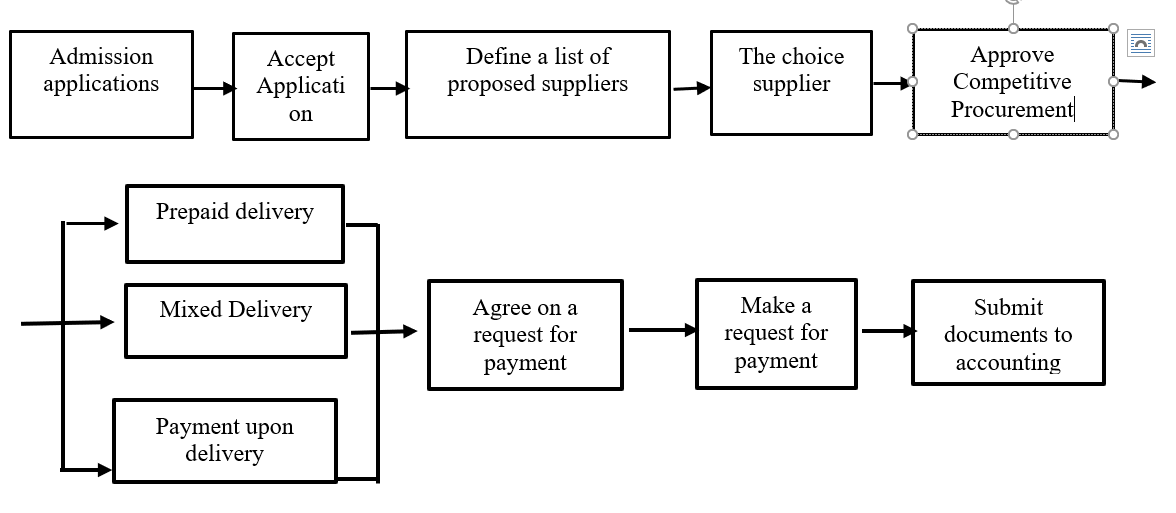
The process of designing and developing economic systems follows the basic principles of software engineering, but it has its own specifics, which should be taken into account in order to improve the quality of development (Abramov, 2013; Gerasimova et al., 2015).
To improve the “Purchasing” process, the interface part was optimized, the diagram of use cases is shown in Figure
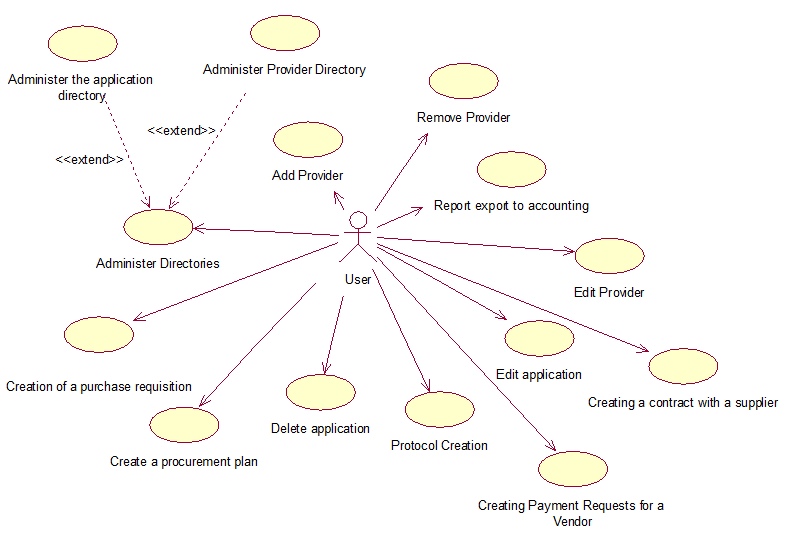
The diagram of use cases (behavior scenarios, use cases) is the initial conceptual representation of the system during its design and development. It makes it possible to understand how the participants in the process act and thereby determine their interaction and impact on the process.
The process is performed in the modern application development environment Embarcadero Rad Studio. All customer requirements were taken into account when developing the software. For the convenience of using the system, a classic interface was developed, and the generally accepted color scheme was applied. The developed software tool does not require special knowledge in the field of information technology; it can work under operating systems of the Windows or Linux family (Gvozdeva & Ballod, 2018; Lavrishcheva, 2016; Mezentsev, 2012).
When the program is launched, the main window-the program menu (Figure
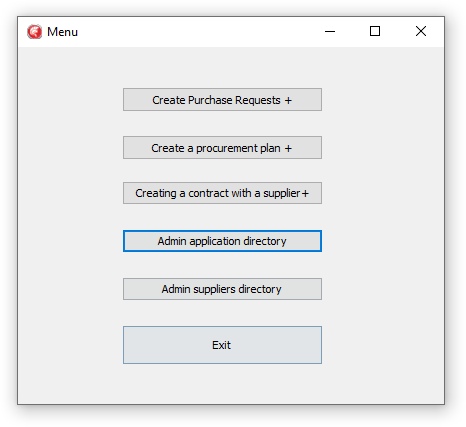
The process of creating a request is shown in Figure
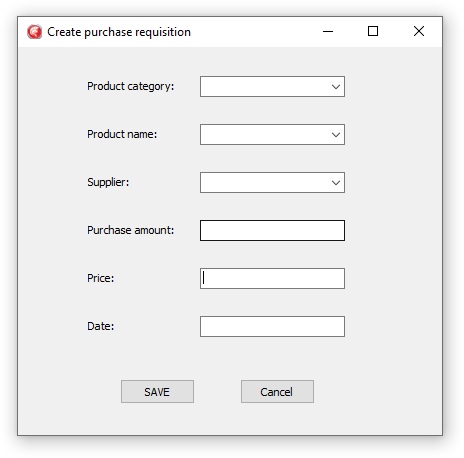
An example of editing the directory «Suppliers» is shown in Figure
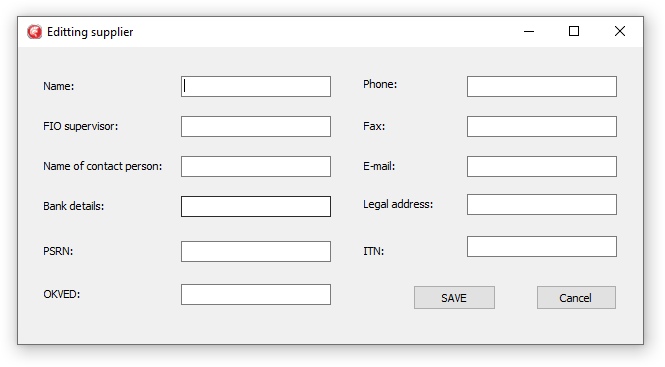
Findings
Based on the proposed measures, we compiled a forecast of economic indicators of the organization of the oil and fat industry (Table
Conclusion
Automation of the «Purchasing» process will allow: 1. Create a purchase plan; 2. Create and approve purchase requests; 3. Creating and approving of a contract with a supplier; 4. Creating and approving requests for payment to the supplier.
Using the software developed by us, you will achieve: 1. Reducing the organization's expenses by selecting the most profitable supplier offers; 2. Guarantee of compliance with all procurement requirements and regulations; 3. Reducing staff labor costs for procurement activities.
In the future, in order to improve the quality of management of the organization of the fat and oil industry, it is planned to improve the functionality of the software by optimizing the database and adding new functionality.
References
- Abakumova Z. V., & Levshina V. V. (2017). Analysis of the enterprise quality management system for compliance with the international standard ISO 9001: 2015. In Start in science: Materials of the IV International Scientific and Practical Conference of schoolchildren, undergraduates, graduate students and graduate students (pp. 178-181). AETERNA. [in Rus.]
- Abakumova, Z. V., & Troshkova E. V. (2019). Quality management organization based on standardization. Resource-efficient systems in management and control: a look into the future. Publishing House of the Tomsk Polytechnic University. [in Rus.]
- Abramov, F. O. (2013). Basic information about UM and, BOUML, diagrams of use cases. Volgograd state technical University. [in Rus.]
- Evans, D. (2015). Quality Management: A Training Manual. Unity. https://biblioclub.ru/index.php?page=book&id=436700 [in Rus.]
- Gerasimova, E. B., Evseichev, A. I., Zlobin, S. V., & Kolmykov, Yu. N. (2015). Quality management: flexible quality management systems: a training manual. Publishing House of FSBEI HPE “TSTU”. [in Rus.]
- Gvozdeva, T. V., & Ballod, B. A. (2018). Design of information systems - computer-aided design technology. Deer. [in Rus.]
- Korotnev, V. V., & Semenova, E. N. (2003). Quality management. Colossus. [in Rus.]
- Lavrishcheva, E. M. (2016). Basic basics of software engineering. Moscow Institute of physics and technology. [in Rus.]
- Mezentsev, K. V. (2012). Automated informational systems. Academy. [in Rus.]
- Mikheeva, E. N., & Seroshtan, M. V. (2017). Quality management: textbook. Dashkov and Co. https://biblioclub.ru/index.php?page=book&id=454086 [in Rus.]
- Nikolaev, M. I. (2016). Metrology, standardization, certification and quality management. National Open University INTUIT. https://biblioclub.ru [in Rus.]
- On approval of the Strategy for improving the quality of food products in the Russian Federation until 2030 (2020). https://docviewer.yandex.ru [in Rus.]
- On approval of the Strategy of the food and processing industry of the Russian Federation for the period until (2020). http://static.government.ru [in Rus.]
- Serenkov, P. S. (2011). Quality management methods. The methodology of organizational design of the engineering component of the quality management system. INFRA-M. [in Rus.]
- Terebkin, A. V. (2012). Quality management: a textbook for bachelors. Publishing house Yurayt [in Rus.]
Copyright information

This work is licensed under a Creative Commons Attribution-NonCommercial-NoDerivatives 4.0 International License.
About this article
Publication Date
21 October 2020
Article Doi
eBook ISBN
978-1-80296-089-1
Publisher
European Publisher
Volume
90
Print ISBN (optional)
-
Edition Number
1st Edition
Pages
1-1677
Subjects
Economics, social trends, sustainability, modern society, behavioural sciences, education
Cite this article as:
Abakumova, Z. V., Popov, A. A., & Levshina, V. V. (2020). Software Development To Improve The Quality Of Organization Management. In I. V. Kovalev, A. A. Voroshilova, G. Herwig, U. Umbetov, A. S. Budagov, & Y. Y. Bocharova (Eds.), Economic and Social Trends for Sustainability of Modern Society (ICEST 2020), vol 90. European Proceedings of Social and Behavioural Sciences (pp. 1189-1196). European Publisher. https://doi.org/10.15405/epsbs.2020.10.03.136

